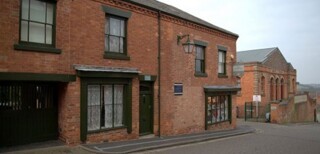8a Victoria Street
John Perry
D.H. Lawrence’s relationship with the town he grew up in, Eastwood in Nottinghamshire, was always ambivalent. Its rural surroundings were ‘the country of my heart’, but the streets of miners’ cottages where his family lived were ‘sordid and hideous’. He freely used Eastwood characters in his writing, and to many locals he was ‘that mucky man’ who’d left the town then rubbished its reputation.
Few residents fought for Lawrence to be recognised in the place which figures so prominently in his novels. One who did was Enid Goodband, who died this month at the age of 91. In the early 1970s, when Eastwood was hardly more beguiling than it had been in Lawrence’s day, the local council had begun to demolish the miner’s terraces, known as 'The Squares' or 'The Buildings', slowly rehousing the retired colliers still living there. There was a snag: in one corner stood 8a Victoria Street, the recently listed house where Lawrence was born in 1885. Unable to demolish it, the council planned to surround it with nondescript flats that would remove any context for the house and possibly pave the way to get rid of it at a later date.
At the end of March 1974, along with the rest of the urban and rural districts of England, Eastwood Council was due to disappear and be replaced by a bigger local authority whose town hall was 12 miles away in Broxtowe. Councillors wanted to finish the demolition before they left office. But in late 1973, the new Borough Council set up a pilot team of town planners, of which I was one. We saw a chance both to save some local heritage and make new plans that were more in line with what residents had told us they wanted. They liked living close to the main street and most wanted their houses kept and improved. The Eastwood Advertiser took up the case. A survey was done and an alternative plan prepared. There was an exhibition of the rival schemes, reluctantly agreed to by the outgoing councillors, a public meeting and a council debate. Public opinion began to turn.
The old council ran out of time. They had refused to change their plans, but kept quiet about a hidden threat to the new ones. The coal mines in which Lawrence’s father had worked were in the last decade of their life, but a new seam was to be driven directly under the old streets, threatening subsidence and requiring the work to be put on hold. It was only when we took over that we found the files with the coal board’s warnings. We struggled to keep the residents’ confidence as delays built up. Finally, late in 1976, work began: 92 houses were kept and improved, and new houses designed to fit into the area were built on the sites of those already cleared.
Most of the surviving houses face onto Princes Street. Today, it’s tree-lined and traffic-free. Round the corner, the modern library with its Lawrence section is still open, even if the nearby Lawrence Heritage Centre recently closed because of government cuts. Broxtowe Council turned 8a Victoria Street into a small museum as part of the improvement scheme, kitting it out as a respectable working-class home of the late 19th century. You can see some of Lawrence’s paintings and other relics. It should also now become a memorial to Enid Goodband, who persuaded the council to buy the house and create the museum. They decided she’d make a good first curator, and it was she who built up the collection and helped make Eastwood a destination for literary tourists.
